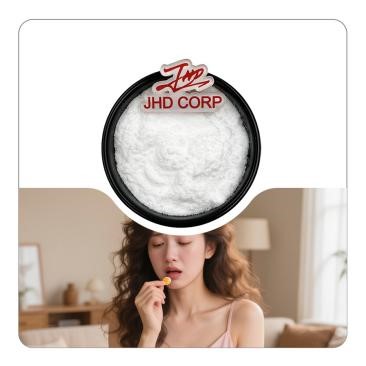Welcome to JHD Nutrasource!
Shop
Neohesperidin Dihydrochalcone
Neohesperidin dihydrochalcone (NHDC) is a flavonoid derivative obtained by hydrogenating neohesperidin extracted from natural citrus plants. It appears as a white or light – yellow powder. It is a high – intensity sweetener with a sweetness 1500 – 1800 times that of sucrose, featuring a refreshing taste, long – lasting aftertaste, and no unpleasant aftertaste like saccharin or stevioside.
Description
| Product Name | Neohesperidin Dihydrochalcone |
| Appearance | Off-white to light yellow crystalline powder |
| Specification | ≥98% |
| Test Method | HPLC |
| Source | through a chemical process |
| Certificate | USP/EP/JP/Kosher/Halal/GMP |
| CAS No | 20702-77-6 |
| MF No | C₂₈H₃₆O₁₅ |
Functions
- Sweetening: It is a low – calorie and high – intensity sweetener, suitable for use in food and beverage products to reduce sugar content while maintaining sweetness. It can also be used in dietary supplements, and its sweetness is similar to that of licorice.
- Bitterness Masking: It can bind to bitter receptors even below its sweetness threshold, effectively reducing the bitterness of pharmaceutical drugs in tablet or syrup form, as well as the bitterness in livestock feed.
- Physiological Activities: It has antioxidant activity, which helps reduce oxidative stress in the body. It can also reduce cholesterol and blood glucose levels. Animal experiments have shown that it can inhibit the activity of HMG – COA reductase and ACAT, reduce the content of plasma cholesterol and neutral lipids, increase the content of high – density lipoprotein (HDL), and prevent cardiovascular complications such as arteriosclerosis. In addition, it may have the effect of inhibiting gastric acid secretion and has potential applications in the development of new – type gastric drugs.
Applications
- Food Industry: It is used as a sweetener in various foods and beverages, such as chewing gum, margarine, and fruit products, which can not only improve sweetness but also enhance flavor and prolong the retention of flavor. It is especially suitable for use in functional foods, health products, and dietary supplements for diabetics and those who need to control calorie intake.
- Pharmaceutical Industry: It is used to mask the bitterness of drugs, improve the palatability of pharmaceutical preparations, and is beneficial to the administration of patients, especially children and the elderly. In addition, due to its potential pharmacological activities, it may also be used as a raw material for the development of new drugs.
- Cosmetic Industry: It is used as a flavoring and perfuming agent in cosmetics to enhance the taste and smell of products, and at the same time, it helps to cover up the unpleasant smell of other ingredients. It has a low comedogenic rating and is suitable for use in products for people prone to acne and blemishes.
- Feed Industry: Adding it to feed can make the feed taste sweeter, increase the appetite of piglets, promote their growth, reduce feed consumption per kilogram of weight gain, and also affect the symbiotic intestinal flora, regulate the body’s immunity, and reduce intestinal diseases.

